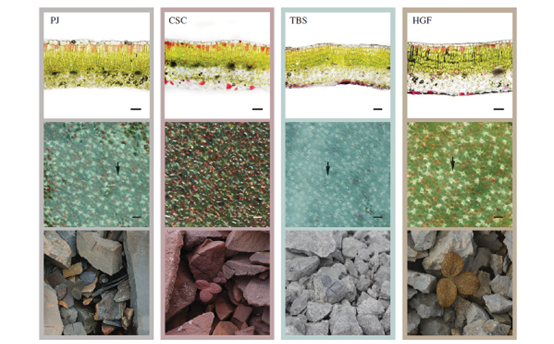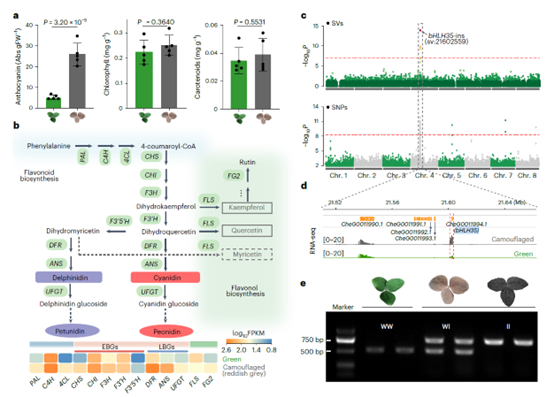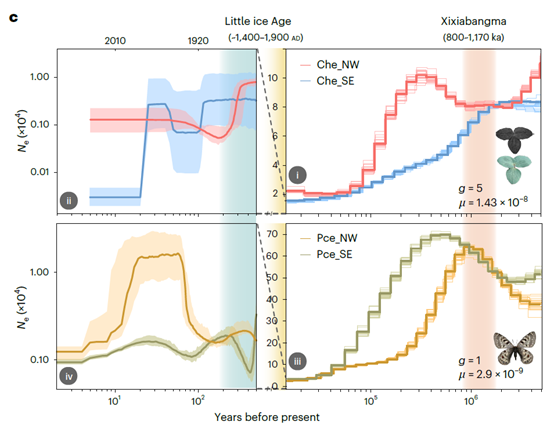Camouflage is a common defensive strategy among animals and has long been a focus in evolutionary biology. By altering their body color and patterns, animals avoid detection or recognition to either ambush prey or evade predators.
Intriguingly, over 40 alpine plant species in the Qinghai-Tibet Plateau and surrounding regions also exhibit typical camouflage coloration. Researchers from the Kunming Institute of Botany, Chinese Academy of Sciences (KIB/CAS) have conducted long-term systematic studies on the evolution of plant camouflage.
Recently, in collaboration with researchers from Lanzhou University, the team unveiled another layer of the evolutionary mechanism behind plant camouflage.
In the high-altitude zones above 4,000 meters in southwestern China, freeze-thaw weathering causes rocks to fracture and accumulate, forming scree slopes (Figure 1).

Figure 1 Alpine scree slopes of the Qinghai-Tibetan Plateau (Image by KIB)
Despite the harsh environment, the subnival zones harbour a variety of endemic flora and fauna. Some Corydalis species exhibit leaf colors that blend with the surrounding rocky substrate, making them nearly indistinguishable—earning them the title of “masters of camouflage”.
These plants serve as hosts for Parnassius butterflies (a genus found in alpine and high-latitude regions of the Northern Hemisphere). Female Parnassius adults rely on visual cues to locate Corydalis hosts and lay eggs nearby.
Their larvae feed on the Corydalis plants after hatching, suggesting that herbivory pressure from these butterflies likely drove the evolution of plant camouflage.
In previous studies, researchersfrom Formation and Innovation of Plant Diversityin Pan-Third Pole Research Group in KIB demonstrated that camouflage enhances individual survival probability without compromising photosynthetic efficiency (Niu et al., 2014). Leaf color varies significantly across different populations to optimize camouflage in different visual rocky backgrounds (Niu et al., 2017).
Additionally, the camouflaged leaves of Corydalis accumulate high levels of anthocyanins, which directly contribute to their cryptic phenotype (Figure 2). However, the genetic basis of this camouflage coloration remained unclear.

Figure 2 The pigment basis of leaf color differentiation in Corydalis hemidicentra. (Image by KIB)
Recently, with leaf color dimorphism (camouflaged and green individuals coexist in certain populations) and inter-population leaf color variation, researchers revealed the genetic mechanism underlying camouflage leaf coloration in Corydalis hemidicentra. (cited from Niu et al.,2017)
Researchers firstly obtained high-quality genomes of two leaf color morphs (camouflage and green), and then combined transcriptomic and metabolomic analyses to reveal how the specific expression of structural genes in the anthocyanin biosynthesis pathway and metabolite accumulation lead to camouflaged leaves.
Using high-quality SV and SNP datasets including 157 plant individuals from six populations, a genome-wide association study (GWAS) identified that a 254-bp transposon insertion in bHLH35 gene (bHLH35-ins) on chromosome 4 strongly correlated with leaf camouflage (Figure 3).
The insertion acts as an enhancer of the bHLH35 gene, increasing transcriptional activity and expression level of bHLH35. As a transcription factor regulating anthocyanin synthesis, elevated bHLH35 upregulates downstream anthocyanin structural genes and promotes anthocyanin accumulation in leaves, giving leaves a rock-like grey color.
This mechanism parallels the classic case of industrial melanism in peppered moths (also mediated by a transposon insertion, increasing melanin production), suggesting convergent evolution in genetics mechanisms between camouflaged plants and animals.

Figure 3 Genetic mechanism of camouflaged leaf coloration in Corydalis hemidicentra. (Image by KIB)
Furthermore, researchers conducted field experiments using decoy leaves made by three-dimensional printing to assess the defensive efficacy of camouflaged plants against Parnassius butterflies (Figure 4).
Results showed that butterflies predominantly visited and oviposited near green plants. In natural setting, camouflaged plants suffered less Parnassius herbivory and had higher fruit set.

Figure 4 Field experiment on Parnassius ovipositing (using decoy leaves), and statistics of leaf herbivory and fruit set for plants. (Image by KIB)
Analyses of plant and butterfly effective population sizes and climate data over the past 500 years revealed a “mirror fluctuation” pattern between plant and butterfly populations: under recent warm periods, green plant populations declined sharply while butterfly populations remained stable; conversely, camouflaged plant populations stayed steady, while populations of Parnassius butterflies have declined (Figure 5).

Figure 5 Demography of plant and butterfly effective population sizes. (Image by KIB)
In summary, by integrating sensory ecology, molecular biology and evolutionary biology, the researchers elucidated the genetic and ecological adaptive mechanisms underlying camouflaged coloration of Corydalis hemidicentra.
This study represents the most comprehensive analysis of plant camouflage and plant-herbivore co-evolution to date, offering novel insights into the survival strategies of alpine plants.
These findings have been recently published in Nature Ecology & Evolution titled “Genetic basis of camouflage in an alpine plant and its long-term co-evolution with an insect herbivore”.
Professor LIU Jianquan (Lanzhou University), Professor Susanne S. Renner (University of Washington), Academician SUN Hang (KIB, CAS), and Professor LI Minjie (Lanzhou University) served as co-corresponding authors. Dr. ZHANF Han and Postdoc ZHANG Pan (Lanzhou University), Professor NIU Yang (KIB, CAS), TAO Tongzhou (Sichuan University), and Master student LIU Gang (Lanzhou University) shared first authorship.
The study was supported by The Second Tibetan Plateau Scientific Expedition and Research Program, the Tibet Autonomous Region Science and Technology Support Program, andStrategic Priority Research Program of the Chinese Academy of Sciences, among others.
Contact:
YANG Mei
General Office
Kunming Institute of Botany, CAS
email: yangmei@mail.kib.ac.cn
(Editor: YANG Mei)




